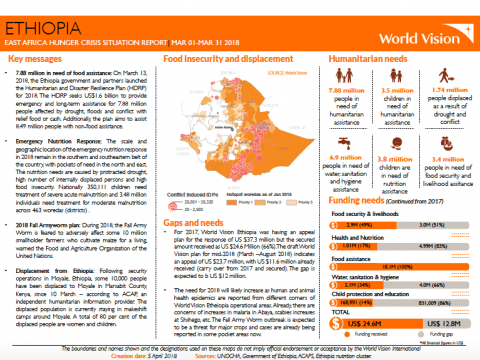Responding to food insecurity in Ethiopia - March 2018
Download
A total of 105,239 people in Ethiopia were reached with World Vision's response to drought, displacement and food insecurity in March 2018.
Still, the response is ongoing.
World Vision is concerned that:
- 7.88 million need food assistance: On March 13, 2018, the Ethiopia government and partners launched the Humanitarian and Disaster Resilience Plan (HDRP) for 2018. The HDRP seeks US$1.6 billion to provide emergency and long-term assistance for 7.88 million people affected by drought, floods and conflict with relief food or cash. Additionally, the plan aims to assist 8.49 million people with non-food assistance.
- 350,000 children require treatment for severe malnutrition: The scale and geographic location of the emergency nutrition response in 2018 remain in the southern and southeastern belt of the country, with pockets of need in the north and east. The nutrition needs are caused by protracted drought, high number of internally displaced persons and high food insecurity. Nationally 350,111 children need treatment of severe acute malnutrition and 3.48 million individuals need treatment for moderate malnutrition across 463 woredas (districts).
- Harvests are threatened by the Fall Armyworm: During 2018, the Fall Army Worm is feared to adversely affect some 10 million smallholder farmers who cultivate maize for a living, warned the Food and Agriculture Organization of the United Nations.
- Thousands are displaced: Following security operations in Moyale, Ethiopia, some 10,000 people have been displaced to Moyale in Marsabit County, Kenya, since 10 March – according to ACAPS, an independent humanitarian information provider. The displaced population is currently staying in makeshift camps around Moyale. A total of 80 per cent of the displaced people are women and children.
For more information about World Vision's response activities, locations and other details, please download (pdf) our March 2018 Situation Report.